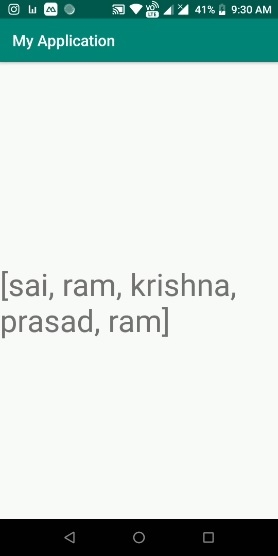
 Data Structure
Data Structure Networking
Networking RDBMS
RDBMS Operating System
Operating System Java
Java MS Excel
MS Excel iOS
iOS HTML
HTML CSS
CSS Android
Android Python
Python C Programming
C Programming C++
C++ C#
C# MongoDB
MongoDB MySQL
MySQL Javascript
Javascript PHP
PHP
- Selected Reading
- UPSC IAS Exams Notes
- Developer's Best Practices
- Questions and Answers
- Effective Resume Writing
- HR Interview Questions
- Computer Glossary
- Who is Who
How to use size() in android ConcurrentLinkedQueue?
Before getting into the example, we should know what ConcurrentLinkedQueue is, it is an unbounded queue based on linked nodes. Multiple threads can access queue elements with safety. Elements travel based on queue strategy as FIFO and elements going to insert from a tail. It does not allow null values.
This example demonstrates about How to use size() in android ConcurrentLinkedQueue
Step 1 − Create a new project in Android Studio, go to File ⇒ New Project and fill all required details to create a new project.
Step 2 − Add the following code to res/layout/activity_main.xml.
<?xml version = "1.0" encoding = "utf-8"?> <LinearLayout xmlns:android = "http://schemas.android.com/apk/res/android" xmlns:app = "http://schemas.android.com/apk/res-auto" xmlns:tools = "http://schemas.android.com/tools" android:layout_width = "match_parent" android:gravity = "center" android:layout_height = "match_parent" tools:context = ".MainActivity" android:orientation = "vertical"> <TextView android:id = "@+id/actionEvent" android:textSize = "40sp" android:layout_marginTop = "30dp" android:layout_width = "wrap_content" android:layout_height = "match_parent" /> </LinearLayout>
In the above code, we have taken a text view to show ConcurrentLinkedQueue elements.
Step 3 − Add the following code to src/MainActivity.java
package com.example.myapplication;
import android.os.Build;
import android.os.Bundle;
import android.support.annotation.RequiresApi;
import android.support.v7.app.AppCompatActivity;
import android.view.View;
import android.widget.TextView;
import java.util.concurrent.ConcurrentLinkedQueue;
public class MainActivity extends AppCompatActivity {
ConcurrentLinkedQueue concurrentLinkedQueue;
String head;
@RequiresApi(api = Build.VERSION_CODES.LOLLIPOP)
@Override
protected void onCreate(Bundle savedInstanceState) {
super.onCreate(savedInstanceState);
setContentView(R.layout.activity_main);
concurrentLinkedQueue = new ConcurrentLinkedQueue<String>();
final TextView actionEvent = findViewById(R.id.actionEvent);
concurrentLinkedQueue.add("sai");
concurrentLinkedQueue.add("ram");
concurrentLinkedQueue.add("krishna");
concurrentLinkedQueue.add("prasad");
concurrentLinkedQueue.add("ram");
actionEvent.setText("" + concurrentLinkedQueue);
actionEvent.setOnClickListener(new View.OnClickListener() {
@Override
public void onClick(View v) {
actionEvent.setText("" +concurrentLinkedQueue.isEmpty());
}
});
}
}
Let's try to run your application. I assume you have connected your actual Android Mobile device with your computer. To run the app from an android studio, open one of your project's activity files and click Run ![]() icon from the toolbar. Select your mobile device as an option and then check your mobile device which will display your default screen –
icon from the toolbar. Select your mobile device as an option and then check your mobile device which will display your default screen –

Now to click on textview, it will give the result as shown below –

Click here to download the project code

